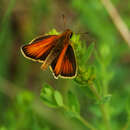Conservation Status
provided by University of Alberta Museums
Status undetermined; may be a rare stray.
- license
- cc-by-nc
- copyright
- University of Alberta Museums
Cyclicity
provided by University of Alberta Museums
Possibly double-brooded, with a late Jun to early Jul and an Aug to Sep flight.
- license
- cc-by-nc
- copyright
- University of Alberta Museums
Distribution
provided by University of Alberta Museums
Eastern United States and southeastern Canada west to extreme eastern Saskatchewan (Layberry et al. 1998, Opler 1999). The only known Alberta record (3 July 1909) from Lethbridge (Bird et al. 1995) is well outside of the known range, and may represent a stray individual.
- license
- cc-by-nc
- copyright
- University of Alberta Museums
General Description
provided by University of Alberta Museums
The small size (19 to 25 mm wingspan), weak flight, in combination with a dark fore- and orange hindwing make this quite a distinctive skipper.
- license
- cc-by-nc
- copyright
- University of Alberta Museums
Habitat
provided by University of Alberta Museums
Restricted to wet meadows and streamsides.
- license
- cc-by-nc
- copyright
- University of Alberta Museums
Life Cycle
provided by University of Alberta Museums
Unknown in Alberta; The egg is yellow with a reddish middle band (Bird et al. 1995). Mature larvae are light green with white patches and lines, a brown head, and live in shelters constructed from grass blades (Layberry et al. 1998). Adults have a weak flight, and fly in amongst tall grasses (Layberry et al. 1998).
- license
- cc-by-nc
- copyright
- University of Alberta Museums
Trophic Strategy
provided by University of Alberta Museums
In Manitoba, Least Skipper larvae feed on bluegrass (Poa spp.) and Rice Cutgrass (Leersia oryzoides) (Layberry et al. 1998), and in North Dakota on Giant cutgrass (Zizaniopsis miliacea) and bluegrass (Poa spp.) (McCabe & Post 1977). Of these, only bluegrasses occur in Alberta (Moss 1992).
- license
- cc-by-nc
- copyright
- University of Alberta Museums

